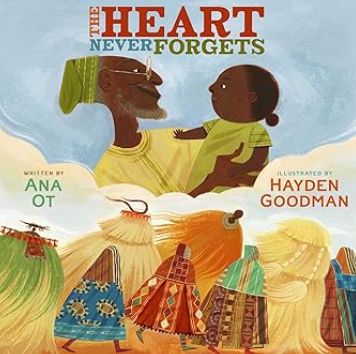The Heart Never Forgets
 The Heart Never Forgets
The Heart Never Forgets
Picture Book / Nigeria / Ages 4-8 / Masquerades
Atheneum Books for Young Readers
978-1665913058
Unpaged

"As villagers gather to hear masked musicians beating drums, savor fried plantains, and watch the joyful dancers, a young girl joins the celebration with her family. But this year, everything feels different; it’s the first masquerade without Grandpa." Publisher
The Heart Never Forgets, written by Ana Ot, is the story of a young girl who attends a celebration of ancestors without her grandfather, who recently passed away. This annual celebration brings together the entire town with music, dancing, and masquerade performers. But the little girl feels distraught without him.
Townspeople gather in the open spaces where food is prepared, where stories are told, where musicians play, and where families converse, waiting for the festivities to begin. The young girl’s father appears wearing the green velvet hat her grandfather always wore. Her mother prepares the grandfather’s favorite food wearing her grandfather’s wooden beads. Her brother, holding the grandfather’s too large walking stick, tries to console his younger sister who thinks she doesn’t have anything with which to honor her grandfather. All her family is bringing something to this important event, except her.
The drums begin to sound, dum, dum, dum, signaling the beginning of the festivities. The family and townspeople share stories about the grandfather. The young girl remembers dancing only when her grandfather played the talking drum. Dum, dum, dum, the drums get more energetic; then the masquerade performers appear. They wear large billowing gowns with flowing fabric strips, others wear costumes of grass topped with a carved sculpture. The performers dance and spin and flip, stirring the dust; some performers are on stilts. The little girl watches their skillful performances all the while remembering her grandfather.
Once the masqueraders disappear, the dancers arrive. They are all wearing matching beautiful blue garments and are lined up for the dance. It is at this point that the little girl remembers her grandfather playing the talking drums and how she danced for him. After some hesitation, she overcomes her anxiety and joins in the dance. Her dance becomes the gift to her grandfather and she dedicates her performance to him.
The colorful, excellent illustrations are by Hayden Goodman. The opening double-page spread illustrates the town set against hills rendered as huge purple boulders. These are possibly a reference to the Idanre Hills of southwestern Nigeria. The houses are set against a warm ochre clearing surrounded by green vegetation. The turquoise, yellow, pink, and white houses have verandas and balconies, and some have parked cars in front. Connecting all the houses are power lines.
Colorfully dressed residents of this town, families with children, women wearing heels and men with pointed shoes, women adorned with beautiful head wraps or wearing earrings and sunglasses, walk through the streets towards the celebration. On subsequent pages, Hayden illustrates the activities by creating small vignettes of women cooking, families sitting and talking, some sharing food, others tending to animals. Spread across two pages, musicians are shown in beautiful patterned gowns of yellow, red and blue, anticipating the masqueraders. The arrival of the masqueraders covers another double-page spread. A second full-page spread has the performers swirl, jump and twirl, creating in two dimensions what in reality would be an acrobatic performance.
The story is about honored traditions and memories held by a community as seen through the eyes of the little girl, the granddaughter of the elder who joined the ancestors. The entire town comes together in a day of commemoration and celebration. The costumes rendered by Haywood seem to be Egungun masqueraders, which the Yoruba people of Nigeria embody to commemorate ancestors.
The illustrations are sophisticated, beautifully stylized to create a sense of visual rhythms throughout the book. The background colors are often earthen, lending a warmth to the pages. The people are rendered in a delightfully abstracted style with added details like a wispy beard for the grandfather, fashionable glasses and sunglasses, and large earrings for women and embroidered shoes and musicians’ eyes that seem to follow the lead of the masqueraders. Goodman closes the story with another double-page spread, showing a village that has turned in for the night; the now blue-grey houses at dusk are illuminated with the electricity that powers the town. At sunset, purple boulders loom large against the sleepy town.
At the end of the story, the author offers a brief explanation about the significance of masquerades in West Africa and their continued importance in contemporary society.
The Heart Never Forgets is a charming story of shared values and traditions, exceptionally well illustrated.
Veronika Jenke, EdD. Retired, Curator of Education
National Museum of African Art, Smithsonian Institution.
Published in Africa Access Review (May 30, 2025)
Copyright 2025 Africa Access
